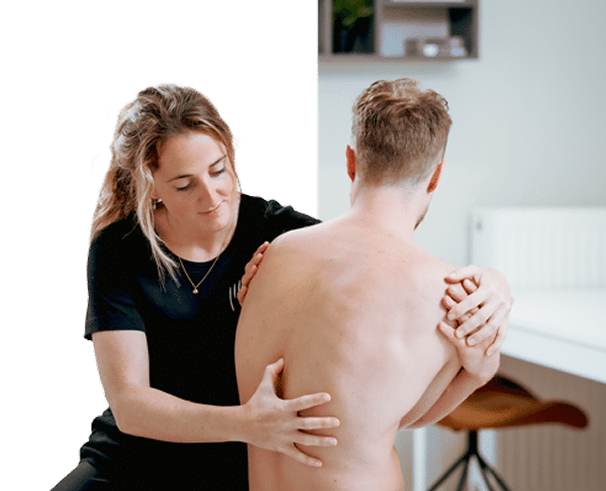Help, my hamstring is bothering me!
A hamstring injury is often caused by intense movements such as sprinting, sudden changes in direction, or forceful push-off movements. This injury is common in athletes, but can also occur during daily activities. Hamstring injuries can be painful and hampering and usually require a thoughtful approach to recovery and prevention of recurrence. Physical therapy can play a big role in this, and at The Physio Man, we offer the specific support to fit your recovery needs. Learn more about hamstring injuries, and what you can do to remedy and prevent them.
In het kort
- What is a hamstring injury? An injury to the muscles at the back of your thigh, often caused by sudden or forceful movements.
- Symptoms: Sharp pain, limited range of motion, swelling, bruising, and muscle weakness.
- Causes: Overuse, sudden movements, and vigorous sports activities such as sprinting, soccer, and dance.
- Treatment: Rest, ICE (Ice, Compression, Elevation) method, and physical therapy to promote recovery.
- Prevention tips: Eccentric exercise, controlled stretching, hydration and nutrition, a gradual return to sports, and performing warm-up and cool-down.
What is a hamstring injury?
The hamstring is a muscle group on the back of your thigh, running from your sit bone to the knee. These muscles are responsible for bending the knee and extending the hip. Injuries to the hamstrings often result from overuse, a sudden movement, or an unexpected force on the muscle. Especially with explosive movements and sports such as soccer, sprinting, and dance, you often see this injury.
Symptoms of a hamstring injury
Hamstring injuries can vary in severity, but the following symptoms are the most common:
- Sharp pain at the back of the thigh: This pain may occur with sudden movement and often feels like a sharp sting.
- Movement restriction: It may be difficult to fully flex or extend your leg.
- Swelling and bruising: In more severe cases, the affected area may swell and turn blue.
- Muscle weakness: The affected leg may feel less powerful, affecting daily movements or athletic performance.

Classification of hamstring injuries
Hamstring injuries are often classified into three degrees:
- 1st degree (minor injury): The muscle is overused but not torn; daily activities are usually possible without pain, but sports may cause some discomfort.
- 2nd degree (moderate injury): There is some damage to the muscle fibers, with marked pain and swelling. Walking and light activities may be painful.
- 3rd degree (severe injury): In this degree, the muscle may be torn. There is intense pain and swelling, and movements such as walking are often possible only with support.
Treatment of a hamstring injury
First aid and self-care
With an acute hamstring injury, rest is essential. It is important to cool the muscle as soon as possible, ideally within minutes of sustaining the injury. By applying the so-called ICE method (Ice, Compression, Elevation), you reduce possible swelling and pain. Cooling is done at 15-minute intervals, always placing a cloth between the ice and the skin to prevent frostbite.
Physical therapy: focused recovery at The Physio Man
With hamstring injuries, physical therapy is an important step in the recovery process. Our physical therapists at The Physio Man offer personalized treatments and exercises that not only help recover from the injury, but also build muscle strength and flexibility to prevent new injuries. Our approach is divided into several phases:
- Recovery Phase: In the initial phase, the emphasis is on light exercises to improve blood flow and promote pain relief, without stressing the hamstring.
- Strengthening Phase: Once the pain subsides, we continue with muscle strengthening exercises such as the Nordic curl to make the hamstrings stronger and more stable.
- Preventive training: Preventing another injury is crucial. Our physical therapists will help you with sport-specific exercises appropriate to your activities, such as stability training and technique improvement.

Return to sports
After a hamstring injury, it is important to build up slowly and work toward full recovery of strength and stability. While daily activities may be able to be performed again, when it comes to sports activities, the hamstring requires more time and training to regain optimal load capacity. It is recommended that you work with physical therapists to create a step-by-step training program that takes into account your personal goals and sports activities.
Tips to prevent hamstring injuries
Preventing a hamstring injury starts with proper preparation and care of the body. Some recommended tips include:
- Eccentric strength exercises: Exercises such as the Nordic hamstring curl help strengthen the hamstrings and protect against tensile stress that often causes injury. Eccentric exercises (where the muscle extends in a controlled manner) can significantly reduce the risk of injury.
- Responsible stretching: Hamstrings are susceptible to strain when stretched incorrectly. While stretching be careful and controlled, without pushing too far, which helps prevent injury. Stretch after a warm-up and make sure your stretches are within your pain limit.
- Adequate hydration and proper nutrition: Muscles recover better and function more optimally with proper nutrition and adequate hydration. Nutrition rich in protein promotes muscle recovery, while hydration stimulates blood flow and prevents cramps. Provide adequate minerals such as magnesium, which can help keep muscles supple and strong.
- Patience and realistic expectations: Many athletes want to recover quickly and return to their original level. However, it is important to give hamstring recovery time and build up the level of training gradually. Patience and a gradual return to sport reduce the risk of re-injury.
- Warm-up and cool-down: These steps prepare and soothe muscles before and after exercise.
- Balance and stability exercises: Regular exercises focused on balance and stability are essential for athletes and reduce the risk of muscle strain.

Physical therapy for hamstring injuries at The Physio Man
At The Physio Man, we understand that a hamstring injury not only causes physical discomfort, but can also be a mental strain for athletes and active people. Our therapists are ready to guide you with a treatment plan that matches your recovery goals and sports level. With personal attention and customized therapies, we will support you in your recovery and help you return to your sport or daily activities stronger and injury-free.
Make an appointment at The Physio Man today and experience how our experienced physical therapists can help you effectively recover from a hamstring injury and improve your physical well-being.
Why choose The Physio Man?
- Latest treatment techniques
- We look at the body as a whole
- 80% of our patients are complaint-free within a few treatments
- No long waiting lists
- Also open in the evening
At The Physio Man, we offer a wide range of treatment options aimed at reducing symptoms and improving quality of life. For questions or an intake consultation, contact us. Email info@defysioman.nl or call 020-3542926. Prefer to come by? Visit us at Jan van Galenstraat 301 in Amsterdam.


